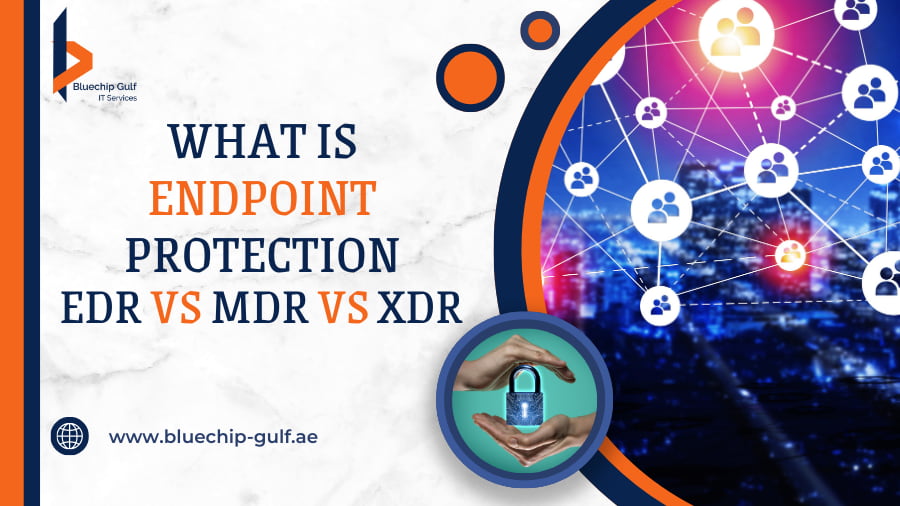
Organizations are continually seeking robust IT security solutions to safeguard their digital assets. Among these remedies, endpoint protection is essential for thwarting complex assaults that aim to compromise endpoints, including computers, laptops, tablets, and servers. In recent years, the emergence of Endpoint Detection and Response (EDR), Managed Detection and Response (MDR), and extended Detection and Response (XDR) has added complexity to the decision-making process for businesses looking to fortify their defenses. Let’s examine these endpoint protection technologies’ distinctions and functionalities.
What is Endpoint Detection and Response (EDR) in Endpoint Protection?
EDR IT security solutions focus on real-time monitoring, detection, and response capabilities tailored specifically for endpoints. These solutions employ advanced analytics, machine learning algorithms, and behavioral analysis to detect and mitigate threats across the endpoint environment. By continuously monitoring endpoint activities, EDR solutions provide organizations with unparalleled visibility into potential security incidents, enabling swift response and remediation actions.
Know the Key Features of EDR in Endpoint Protection
Threat Detection – EDR solutions excel in identifying known and unknown threats through behavioral analysis and signature-based detection techniques. By correlating endpoint data with threat intelligence feeds, EDR solutions can swiftly identify and respond to malicious activities.
Investigation and Response – EDR IT security solutions empower security teams with detailed forensic data and investigative tools to analyze the root cause of security incidents. This minimizes the impact on the organization by enabling quick reaction and threat containment.
Endpoint Visibility – Comprehensive visibility into endpoint activities, including file updates, network connections, process execution, and user behavior, is provided by EDR systems. This granular visibility enables proactive threat hunting and detection of anomalous behavior.
What is Managed Detection and Response (MDR) in Endpoint Protection?
MDR IT security solutions extend beyond traditional EDR capabilities by combining advanced technology with human expertise to deliver proactive threat detection and response capabilities. MDR providers leverage a team of skilled security analysts who continuously monitor and analyze endpoint data to identify emerging threats and security vulnerabilities. By outsourcing the management of endpoint security to MDR providers, organizations can augment their internal security teams with additional expertise and resources.
Understand the Key Features of MDR in Endpoint Protection
24/7 Monitoring and Analysis – MDR vendors provide continuous endpoint telemetry data monitoring and analysis to quickly identify and address security incidents. By taking a proactive stance, threats are promptly identified and mitigated, reducing the possibility of data breaches and system intrusions.
Incident Response and Remediation – MDR IT security solutions contain incident response capabilities, enabling rapid containment and remediation of security incidents. MDR analysts work closely with organizations to orchestrate response actions and implement remediation measures to restore the integrity of the endpoint environment.
Threat Intelligence Integration – MDR providers leverage threat intelligence feeds and proprietary threat research to enhance threat detection capabilities. By staying abreast of the latest cyber threats and attack techniques, MDR services can effectively identify and neutralize emerging threats before they escalate into full-blown security incidents.
What is Extended Detection and Response (XDR) in Endpoint Protection?
With its unified approach to threat detection and response across several security levels, XDR is the next step of endpoint protection. Unlike EDR and MDR, which focus primarily on endpoints, XDR solutions integrate telemetry data from various IT security solutions, including endpoints, networks, cloud environments, and email gateways, to provide comprehensive threat visibility and analysis.
Know the Key Features of XDR in Endpoint Protection
Cross-Layer Detection and Analysis – XDR solutions correlate telemetry data from disparate security sources to identify complex threats that span multiple attack vectors. By analyzing data across endpoints, networks, and cloud environments, XDR solutions offer enhanced threat detection capabilities and contextual insights into security incidents.
Automated Response and Orchestration – XDR IT security solutions leverage automation and orchestration capabilities to facilitate incident response procedures and underestimate manual intervention. By automating response actions based on predefined playbooks and security policies, XDR solutions enable rapid containment and remediation of threats.
Centralized Management and Visibility – XDR solutions provide centralized management and visibility across the entire security infrastructure, enabling security teams to monitor, analyze, and respond to threats from a single console. This holistic approach enhances operational efficiency and enables associations to adopt a militant stance toward cybersecurity.
Final Words
EDR, MDR, and XDR represent distinct approaches to endpoint protection, each offering unique capabilities and advantages. MDR expands on EDR’s endpoint-specific real-time monitoring and response capabilities by offering proactive threat detection and response services. On the other side, XDR provides thorough visibility and analysis of security incidents, offering a unified approach to threat detection and response across several security levels.
Ultimately, the choice between EDR, MDR, and XDR depends on the specific security requirements and objectives of each organization, as well as the level of expertise and resources available to manage endpoint security effectively. Regardless of the chosen approach, investing in robust endpoint protection solutions is essential for safeguarding against evolving cyber threats and ensuring the resilience of the organization’s digital assets.
Also Read, Secure Endpoint Data Backup Protection

